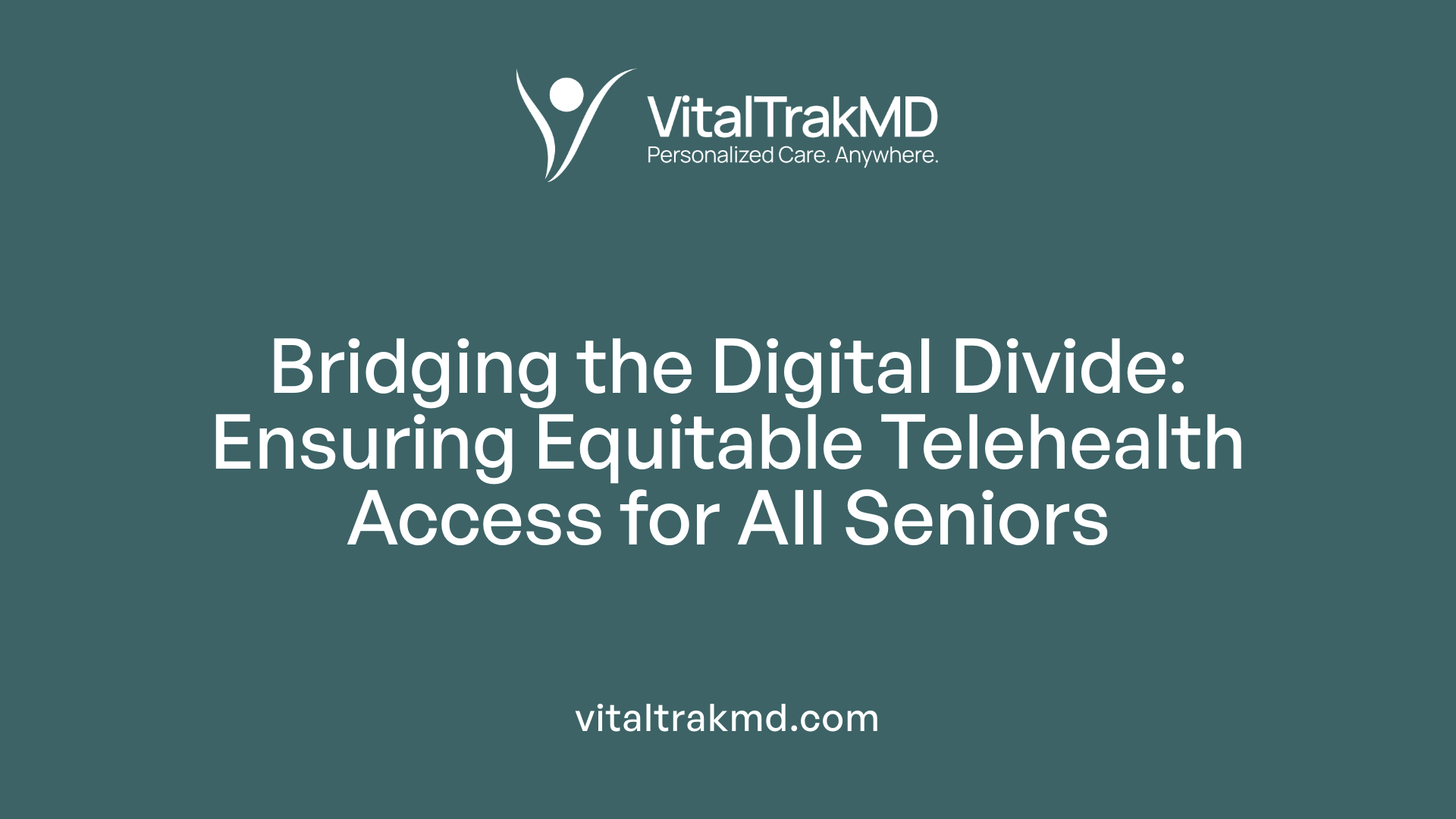Maximizing Telemedicine Features for Better Senior Health Outcomes

Enhancing Senior Healthcare Through Innovative Telehealth Strategies
The rapid adoption of telemedicine during the COVID-19 pandemic has revolutionized healthcare delivery for older adults. By leveraging emerging technologies and best practices, healthcare systems can optimize telehealth features to improve health outcomes, patient experience, and engagement among seniors. This article explores strategies, challenges, and future directions for maximizing telemedicine in elderly care, emphasizing equity, safety, and effectiveness.
Impact of Telemedicine on Senior Health Management and Patient Engagement

What is the impact of telemedicine on health management, patient experience, and engagement among seniors?
Telemedicine has transformed healthcare delivery for older adults by allowing remote management of medical conditions. It enables continuous health monitoring, especially for chronic illnesses like diabetes, hypertension, and heart failure, leading to better disease control and clinical outcomes. For example, remote patient monitoring tools such as blood pressure cuffs and glucose meters help providers adjust treatments promptly.
Patients benefit from the convenience of virtual visits, which reduce the need for traveling, a common barrier for seniors with mobility issues or those living in rural areas. This accessibility increases their engagement in regular health checkups and follow-up care. Many seniors report high satisfaction levels, citing ease of use—around 64% found telehealth visits very easy—and appreciate the ability to communicate effectively with healthcare professionals.
Moreover, telehealth fosters stronger patient-provider communication through personalized interventions. Virtual platforms often support tailored education, medication management, and disease self-management strategies. For seniors coping with conditions like chronic kidney disease or dementia, these interventions help enhance adherence and understanding, strengthening their capacity to manage health independently.
Despite challenges such as limited digital literacy or broadband access, targeted support like caregiver assistance, user-friendly interfaces with large buttons, and bilingual services improve usability among diverse populations. Policy changes, including expanded reimbursement for audio-only visits, also facilitate broader access for marginalized groups.
Overall, telemedicine promotes extensive engagement with healthcare, supports long-term health management, and improves the overall quality of life for older adults. Incorporating hybrid models—combining virtual and in-person visits—ensures comprehensive physical assessments and laboratory testing are maintained, further optimizing senior healthcare.
| Aspect | Benefits | Challenges | Enhancements |
|---|---|---|---|
| Chronic Disease Monitoring | Better control, early intervention | Digital literacy, device access | Education, caregiver support |
| Patient Satisfaction | Convenience, reduced travel | Tech usability, trust issues | User-friendly platforms, personalized training |
| Engagement & Adherence | Active participation, education | Socioeconomic disparities | Tailored interventions, multilingual options |
| Disparities & Barriers | Access in rural/low-income areas | Broadband, device availability | Infrastructure investment, policy support |
Benefits, Challenges, and Opportunities in Senior Healthcare Delivery via Telemedicine

What are the benefits, challenges, and opportunities of telemedicine in senior healthcare delivery?
Telemedicine has become an integral part of healthcare, especially since the COVID-19 pandemic, with profound benefits for older adults. It enhances access to care by overcoming barriers such as mobility issues, transportation challenges, and geographic remoteness. For seniors with chronic conditions like heart failure, diabetes, or hypertension, remote monitoring and virtual consultations facilitate ongoing disease management and timely interventions without the need for frequent in-person visits.
In addition, telehealth improves patient engagement and adherence by providing more frequent touchpoints and empowering seniors to participate actively in their health management. Many older adults report high satisfaction levels with telemedicine, citing its convenience and the ability to consult healthcare providers from the comfort of home.
However, despite these advantages, certain hurdles remain. Technological literacy is a major barrier; many seniors face difficulties using digital platforms due to sensory impairments, unfamiliarity with devices, or low digital literacy. Privacy and security concerns, although manageable, can also hamper trust and usage. Structural issues such as limited broadband access, especially in rural areas, further restrict effective use.
Reimbursement and regulatory barriers pose additional challenges. Variability in coverage, especially for audio-only visits, affects equitable access. The lack of physical examinations and diagnostics that are possible in face-to-face visits sometimes limits clinical thoroughness.
Opportunities for advancing telehealth include developing user-friendly, age-tailored telemedicine platforms featuring large text, simple interfaces, and voice commands. Integrating emerging technologies like artificial intelligence for diagnostics, virtual reality for therapy, and advanced remote monitoring tools can enhance clinical outcomes. Policy reforms such as expanding coverage for audio-only visits, cross-state licensure agreements, and dedicated funding for digital health infrastructure are critical for wider adoption.
A hybrid care model that combines virtual consultations with periodic in-person visits ensures comprehensive care, addressing physical examination needs and maintaining personal connection.
Overall, leveraging technological innovations, supportive policies, and tailored education programs can maximize telemedicine's potential to improve health outcomes and quality of life for older adults.
Designing Elderly-Centric Telehealth Platforms and User Support

How can telemedicine be optimized to better serve elderly patient care?
To improve telemedicine services for older adults, it is vital to prioritize platform usability and accessibility. User-friendly interfaces with large buttons, contrasting colors, and simple navigation help overcome common usability challenges faced by seniors. Devices such as smartphones and tablets should be compatible with assistive features like enlarged text, closed captioning, and voice commands, making digital tools more approachable.
Providing comprehensive technical support and involving caregivers in the process can significantly enhance older patients' confidence in using telehealth. Support hotlines, on-site staff assistance in senior living facilities, and step-by-step guides tailored to the elderly help bridge the digital divide. Regular training initiatives—like workshops and personalized onboarding—empower seniors to independently log on, manage appointments, and troubleshoot common issues.
Education programs, including webinars and printed materials, should address digital literacy, emphasizing data security and privacy, which are common concerns. These initiatives can be delivered in multiple languages and adapted to different cultural contexts, ensuring inclusivity and trust.
Accessibility features are essential. Telehealth platforms should incorporate large, easy-to-read text, high-contrast visuals, and compatibility with various devices, including those with touchscreens or voice activation. Integrating remote monitoring devices—such as blood pressure cuffs, glucose meters, and activity trackers—can facilitate ongoing management of chronic diseases, reducing hospital readmissions and supporting independence.
Finally, policies supporting reimbursement and telehealth regulations, alongside technological improvements to expand broadband access in rural and underserved areas, are crucial. Together, these strategies create a supportive healthcare environment that effectively meets the needs of the elderly, promoting sustained engagement and better health outcomes.
Telemedicine’s Role in Managing Chronic Conditions Like Heart Failure
What is the role of telemedicine in managing chronic conditions such as heart failure in seniors?
Telemedicine has become a crucial tool in managing chronic diseases like heart failure among older adults. It provides a way to continuously monitor patients’ health status remotely, allowing healthcare providers to gather real-time data on vital signs and symptoms without requiring frequent in-person visits. This ongoing vigilance enables earlier detection of health deterioration, facilitating prompt interventions that can prevent hospitalizations and even save lives.
Remote patient monitoring (RPM) systems are at the core of this approach. Devices such as blood pressure cuffs, glucose meters, and weight scales are connected to telehealth platforms, supplying physicians with vital information. This continuous data flow supports personalized treatment plans, medication adjustments, and lifestyle recommendations tailored to each patient’s condition.
How does telemedicine assist in early detection and intervention?
One of the greatest advantages of telemedicine in cardiovascular care is early identification of worsening symptoms. Regular monitoring helps detect subtle changes—like increasing weight or blood pressure—that may indicate fluid overload or other complications of heart failure.
By utilizing alerts and data visualization, healthcare teams can intervene before crises occur, reducing emergency room visits and unplanned hospital stays. Early intervention not only improves health outcomes but also enhances patients’ confidence in managing their diseases.
How does telemedicine support medication adherence?
Medication management is vital for senior patients with heart failure, as proper adherence can significantly influence disease progression. Telehealth platforms facilitate timely medication reminders, virtual check-ins about medication intake, and quick adjustments if adverse effects arise.
Providers can also review medication regimens during virtual visits, ensuring patients understand their prescriptions and address any barriers to compliance. Involving caregivers through telemedicine further strengthens adherence and overall care coordination.
What are the clinical benefits and evidence supporting telehealth for seniors with heart failure?
Research indicates that integrating telehealth into heart failure management yields positive clinical outcomes. For instance, studies reveal that remote monitoring reduces mortality rates and hospitalizations related to cardiovascular issues. The TIM-HF2 trial demonstrated fewer unplanned hospitalizations and lower mortality among patients on remote monitoring programs.
Systematic reviews show modest but meaningful improvements in blood pressure control and glycemic management, along with reduced symptoms of depression, when telehealth is properly utilized. These benefits are especially pronounced in older adults with multiple chronic conditions, as telemedicine helps streamline their complex care routines.
Summary Table of Telemedicine Benefits in Heart Failure Care
| Benefit | Evidence | Additional Notes |
|---|---|---|
| Reduced hospitalizations | TIM-HF2 trial | Significant decrease in unplanned cardiovascular hospital stays |
| Improved medication adherence | Multiple studies | Virtual check-ins help maintain treatment plans |
| Better symptom monitoring | Systematic reviews | Enables early detection and intervention |
| Enhanced quality of life | Patient surveys | Increases independence and engagement |
| Cost-effective care | Economic analyses | Decreases healthcare costs by preventing complications |
Despite challenges such as digital literacy and access to reliable internet, the evidence strongly supports telemedicine as an effective method of managing chronic heart failure in seniors. Proper implementation—through user-friendly platforms, caregiver involvement, and supportive policies—can maximize benefits and improve health outcomes for this vulnerable population.
Effective Practices for Leveraging Telemedicine for Better Outcomes in Seniors
What are the best practices for maximizing telemedicine features to improve health outcomes in seniors?
To ensure telemedicine is most effective for older adults, healthcare providers should focus on creating personalized, patient-centered care models. This involves customizing telehealth platforms with large buttons, clear text, and simple interfaces that are compatible with smartphones and tablets. By doing so, seniors find it easier to navigate and use these technologies independently.
Involving caregivers and family members plays a vital role. Caregivers can assist seniors in managing technology, ensuring effective communication during virtual visits, and supporting medication adherence. This collaborative approach not only improves the quality of telehealth interactions but also helps address technological barriers.
Technology training and personalized onboarding are essential steps. Offering individual or group training sessions, instructional guides, and ongoing technical support can help seniors build confidence in using telehealth platforms. Tailoring these educational initiatives to the specific needs and learning paces of older adults ensures they feel comfortable and engaged.
Feedback mechanisms are crucial for continuous improvement. Regularly collecting patient and caregiver feedback enables healthcare providers to identify challenges and refine telehealth services accordingly. Incorporating patient suggestions helps in addressing usability issues, cultural sensitivities, and specific health needs.
Furthermore, integrating functionalities that support comprehensive care—such as remote patient monitoring for chronic conditions, mental health resources, and medication management—can enhance the holistic approach to senior healthcare. Ensuring privacy and emphasizing trust through transparent communication about data security and system reliability foster confidence among older users.
Finally, addressing broader barriers like internet access, digital literacy, and cultural competence through targeted interventions can widen access and optimize the benefits of telemedicine. This includes advocating for policies that expand broadband coverage, developing culturally sensitive services, and supporting infrastructure investments.
In summary, maximizing telemedicine benefits for seniors hinges on an approach that combines technology-friendly design, caregiver involvement, tailored education, ongoing feedback, and comprehensive, patient-centered care protocols. These practices collectively promote better health engagement, adherence, and outcomes, making telehealth a powerful tool in advancing senior healthcare.
Research and Evidence Supporting Telemedicine Efficacy in Older Adults
What evidence exists regarding the effectiveness of telemedicine for older adults?
Research on telemedicine for seniors shows promising results. Multiple clinical trials and systematic reviews indicate that telehealth interventions can improve management of chronic conditions such as hypertension, diabetes, and heart failure.
Studies reveal significant benefits, including reductions in systolic blood pressure and lowering HbA1c levels. For instance, telemedicine approaches have shown an average systolic blood pressure decrease of approximately 3.83 mmHg and a reduction in HbA1c levels by about 0.20%, highlighting better blood sugar control.
Mental health outcomes have also improved with telepsychiatry services. Many seniors experienced alleviation in depressive symptoms, with some studies reporting an average reduction of 3.11 points on the PHQ-9 scale after virtual interventions.
Patients generally express high satisfaction with telehealth visits, citing convenience and safety. Around 64% of older adults find telehealth very easy to use, and many appreciate the time savings and reduced travel burdens, especially important for those with mobility challenges or residing in rural areas.
Safety is another critical aspect. Telemedicine often includes remote monitoring tools, which help track vital signs and manage medications, lowering hospitalization rates and supporting disease management.
Despite obstacles such as digital literacy gaps, limited broadband access, and user interface difficulties, targeted education, caregiver involvement, and user-friendly platforms help overcome these barriers. These strategies, coupled with supportive policies, enhance adoption among the elderly.
Overall, evidence supports that well-designed telehealth programs can lead to improved health outcomes, increased healthcare access, and high patient satisfaction among older adults. When integrated into standard care, telemedicine becomes a valuable tool to support aging populations effectively.
Building Trust, Managing Expectations, and Enhancing Control in Telehealth for Seniors

How can telehealth improve trust, expectations, and the sense of control among elderly populations?
Telehealth plays a vital role in fostering trust between older adults and healthcare providers by emphasizing consistent, clear, and reliable communication. When seniors experience dependable virtual consultations, timely follow-ups, and easy-to-understand instructions, their confidence in digital services grows. The transparency around safety measures, data security, and providers' professionalism helps cement this trust.
Setting realistic expectations is equally important. Educating older patients about what telehealth can and cannot do—such as managing chronic conditions, offering regular check-ins, and providing mental health support—reduces frustration and increases their confidence in using these services. Highlighting that telehealth is an effective supplement, not a complete replacement, helps align expectations with actual capabilities.
Expanding perceived control over their healthcare is another crucial aspect. When telehealth platforms are designed to be user-friendly—featuring large buttons, simple navigation, and compatibility with devices seniors already use—they empower older adults to independently access their health information and communicate with providers. Enhancing digital literacy through targeted training, caregiver involvement, and personalized onboarding reduces technological anxiety and cultivates a sense of mastery.
Incorporating social engagement and narrative elements can also strengthen relationships. Virtual storytelling, shared experiences, and community-based telehealth initiatives foster a sense of belonging and trust. When older adults feel connected and supported, their willingness to engage with telehealth services improves.
Overall, successfully building trust and managing expectations through transparent communication, reliable technology, and empowering practices enhances older adults' sense of control. This comprehensive approach encourages continued use, improves health outcomes, and fosters independence.
Strategies to build trust, set expectations, and improve perceived control
| Strategy | Focus Area | Details |
|---|---|---|
| Consistent and transparent communication | Trust building | Regular updates, clear instructions, and honest discussions about capabilities |
| Providing education and training | Digital literacy and control | Workshops, simple guides, caregiver involvement, and personalized onboarding |
| Designing elderly-friendly platforms | Usability | Large icons, easy navigation, and device compatibility |
| Setting clear, achievable goals | Expectation management | Clarify telehealth scope, benefits, and limitations |
| Promoting social and narrative engagement | Emotional connection | Community stories, virtual group activities, and shared success stories |
How do trust, expectations, and control influence telehealth adoption among seniors?
Research indicates that high levels of trust in telehealth safety, data security, and provider reputation directly correlate with broader and more confident use of digital health services by older adults. When seniors expect telehealth to improve convenience, health management, and communication, they are more motivated to participate actively.
Enhancing perceived control—through easy-to-use technology and opportunities for independent navigation—further encourages sustained engagement. Seniors who feel empowered and in command of their health decisions are more likely to adopt and benefit from telemedicine long-term.
In conclusion, focusing on trust, realistic expectation setting, and perceived control creates a positive feedback loop that increases telehealth utilization, improves health outcomes, and fosters a sense of independence among older populations.
Addressing Disparities and Ensuring Equitable Access in Telemedicine for Seniors

What are the barriers and disparities in telehealth access among older adults, and how can they be addressed?
Older adults face several barriers to effective telehealth utilization, which can widen existing health disparities. The most common obstacles include limited digital literacy, unfamiliarity with new technologies, lack of necessary devices such as smartphones, tablets, or computers, and inadequate internet connectivity. These issues are often compounded by physical and sensory impairments like vision or hearing loss, making technological use more difficult.
Socioeconomic factors significantly influence access to telemedicine. Lower-income seniors are less likely to own devices or have broadband access, which restricts their ability to participate in virtual healthcare services. Racial and ethnic disparities also exist, with racial minorities, including Black Non-Hispanic and Hispanic older adults, less likely to use digital health tools, due largely to structural inequities such as lower income, lower digital literacy, and poorer access to high-speed internet.
Biases such as ageism, ableism, and systemic racial discrimination exacerbate these gaps, leading to underutilization of telehealth among marginalized groups. They may experience distrust in technology or healthcare providers and face cultural barriers that reduce comfort and engagement.
To bridge these gaps, comprehensive and targeted strategies are essential. Providing affordable or donated devices and ensuring community-based internet access through public Wi-Fi hubs can help mitigate connectivity issues. Technological assistance through caregiver support and dedicated staff can improve digital literacy, enabling seniors to navigate telehealth platforms independently.
Culturally competent care is vital, including offering services in different languages, respecting cultural norms, and training providers on cultural sensitivity. Implementing multilingual interfaces and interpreter services ensures that language barriers do not hinder access.
Healthcare systems should also incorporate systematic screening to identify individual barriers and tailor interventions accordingly. Outreach initiatives, educational workshops, and user-friendly guides can empower seniors to use telehealth confidently.
Addressing implicit biases among healthcare providers through training fosters equitable treatment and encourages engagement among diverse patient populations. Collaborations with community organizations can facilitate trust and awareness, leading to increased adoption.
Ultimately, creating an inclusive telehealth environment requires coordinated efforts across technology access, education, cultural competence, and policy reforms, considering the unique needs of all older adults to promote health equity and improve overall outcomes.
Supporting Multimorbidity and Complex Needs in Senior Telehealth Programs
How can telehealth services be better designed to support elderly patients with multimorbidity?
Supporting older adults with multiple chronic conditions through telehealth requires a thoughtful, patient-centered approach. It’s essential to develop integrated care models that address the intricate health needs of this population. One effective framework is the 4M model—focusing on Medication management, Mentation (mental health), Mobility, and What Matters to the patient—ensuring comprehensive care.
Designing user-friendly telehealth platforms is crucial. Interfaces should feature large buttons, simple navigation, and clear instructions to overcome technological barriers. Visual contact via video calls should be prioritized to foster better communication and trust, making virtual consultations feel more like in-person visits.
Regular follow-up and continuous monitoring are vital components. Scheduling periodic check-ins allows healthcare providers to assess progress and modify care plans as needed. Remote monitoring devices like blood pressure cuffs, glucose meters, and wearable activity trackers can help track physiological measures consistently, providing real-time data for timely intervention.
Involving caregivers and multidisciplinary teams can significantly enhance care quality. Caregivers often assist with technology use and can provide additional health insights, especially when patients have cognitive or physical limitations. Training healthcare staff about elderly-specific needs and cultural competence ensures respectful, effective communication.
Addressing health disparities is imperative. Telehealth programs should be culturally sensitive and accessible, considering language preferences and socioeconomic challenges. Tailoring services to diverse needs promotes equity and wider adoption.
In summary, implementing structured, age-friendly telehealth initiatives that combine personalized plans, technology support, and multidisciplinary collaboration can improve health outcomes for seniors with multimorbidity. These strategies not only enhance access and engagement but also empower older adults to manage their health more effectively.
Developing Policies and Principles for Telehealth in Geriatric Care
How can policies and best practices be developed to improve telehealth for elderly care?
Creating effective policies for telehealth in older adult care requires a foundation built on principles that prioritize person-centered, equitable, and well-integrated care. Starting with established guidelines from organizations such as the Center for Transformation in Aging (C4TA), policymakers should emphasize usability, privacy, and accessibility. This involves setting standards for user interface design—large buttons, easy-to-read text, and compatible devices like smartphones and tablets—and ensuring platforms accommodate cognitive or physical limitations common among seniors.
Addressing technological barriers is critical. Policies should promote digital literacy programs tailored for older adults, support caregiver involvement, and provide resources for troubleshooting. Moreover, regulations must safeguard data security and privacy, complying with laws such as HIPAA, to build trust among users.
Training healthcare providers and caregivers is another essential step. Establishing standardized educational modules on telehealth best practices promotes consistent, safe, and effective care delivery. These trainings should cover technical skills, cultural competency, and privacy protocols.
Stakeholder collaboration enhances policy effectiveness. Engaging seniors, caregivers, healthcare providers, and technology developers ensures that policies are practical, relevant, and responsive to actual needs. Incorporating feedback from these groups allows for continuous improvement.
Future strategies should include ongoing monitoring and evaluation of telehealth outcomes to identify areas for improvement. Community engagement initiatives can foster acceptance and address cultural sensitivities. Tailoring implementation plans to diverse populations, especially underrepresented and vulnerable groups, ensures equitable access.
In summary, developing robust telehealth policies for older adults involves integrating technological standards, training, privacy safeguards, and inclusive stakeholder participation. This comprehensive approach aims to maximize the benefits of telehealth, improve health outcomes, and support the independence of seniors.
Future Trends and Innovations in Senior Telehealth
What future developments can further enhance telehealth services for seniors?
The landscape of telehealth for older adults is poised for significant technological advancements that will improve accessibility, personalization, and effectiveness. One of the most promising areas is the integration of artificial intelligence (AI). AI can assist clinicians in diagnosing health conditions more accurately, developing tailored treatment plans, and analyzing large sets of health data to predict potential health issues before they become critical. This proactive approach can lead to better health outcomes and more efficient use of healthcare resources.
Virtual reality (VR) therapies are also emerging as valuable tools in senior care. VR can be used to provide cognitive therapy for conditions such as dementia and depression, offering immersive environments that stimulate mental engagement and social interaction. Additionally, VR-based physical rehabilitation programs can motivate seniors to perform therapeutic exercises at home, enhancing recovery and mobility.
Predictive health monitoring is set to become a cornerstone of long-term care, utilizing wearable sensors and remote devices to continuously track vital signs, activity levels, and other health indicators. This ongoing data collection enables healthcare providers to identify early signs of deterioration or illness, allowing for timely interventions that can prevent hospitalizations and improve management of chronic diseases.
Robot-assisted care is another innovative frontier, where robots serve as companions, assist with daily routines, and support remote monitoring. These devices can help reduce loneliness, encourage physical activity, and ensure safety within the home environment. For instance, robots equipped with sensors can alert caregivers to emergencies or changes in behavior that may indicate health problems.
These forward-looking technologies will make telehealth more interactive, personalized, and effective for seniors. By addressing their unique needs—such as mobility limitations, cognitive decline, and social isolation—these innovations are expected to significantly enhance quality of life, foster independence, and enable aging in place.
In summary, future developments like AI, VR, predictive sensors, and robotic helpers are set to revolutionize senior telehealth, making healthcare delivery more responsive, engaging, and suited to the evolving challenges of aging populations.
Optimizing Telehealth for a Healthier Future in Geriatrics
Maximizing telemedicine features for better senior health outcomes requires a comprehensive approach that addresses technological, systemic, and human factors. By designing accessible platforms, supporting digital literacy, implementing evidence-based practices, and fostering policy reforms, healthcare systems can unlock telehealth’s full potential. Emphasizing equity, patient trust, and continuous innovation will ensure that older adults receive safe, effective, and personalized care, ultimately leading to healthier, more autonomous aging populations.
References
- Telemedicine in the primary care of older adults: a systematic mixed ...
- Maximizing Telehealth for Elderly Patients - Updox
- How Expectations and Trust in Telemedicine Contribute to Older ...
- Designing Telemedicine for Older Adults With Multimorbidity
- Telehealth and Health Equity in Older Adults With Heart Failure
- Closing the gap: Technology access and telehealth use among ...
- Telemedicine Revolution: Transforming Senior Healthcare in 2025
- Telemedicine Solutions for Senior Citizens: Enhancing Healthcare ...
Recent articles
Want to Feel Better and Live Healthier?
Join hundreds of patients taking control of their health with personalized care that fits their life – not the other way around.
Rated 4.8/5 by 32+ customers







